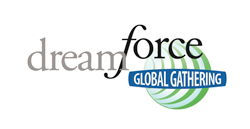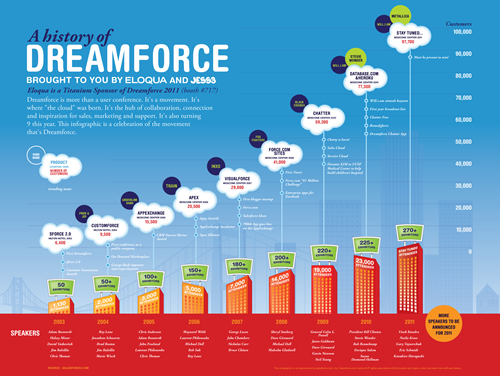The first Dreamforce, the Salesforce user conference occurred in 2003, showcasing 50 exhibitors and drew 1,130 attendees. My first thought in seeing that was…really? Dreamforce has only been around for 8 years? It feels like much longer...in a good way.
This year, Dreamforce will have 270+ exhibitors and I'm guessing will exceed last year's 23,000 attendees. I did the math for you. Last year's attendees exceeded the first year's by 19x. And what’s important about that is it reflects how much bigger Salesforce has grown over the same period.
In 2003, Salesforce had 6,400 customers. Today, the company has almost 98,000 or about 14x more than in 2003.
Eloqua and Jess3 teamed together to create a nifty infographic about the rise of Dreamforce.
Click image to enlarge.
Gartner released its 2011 SCRM Magic Quadrant a few days ago. This year, Gartner moved Salesforce into the leader quad because of the robustness of Service Cloud. The CRM company’s increasing success with Chatter and its acquisition of Radian6 are the reason for its crossover.
Salesforce’s Social CRM capabilities, through Service Cloud, allow users to:
- Monitor and analyze social conversations across the web.
- Pull conversations from Facebook and Twitter into the application and create cases – Want to bet that Google+ is coming?
- Auto-generate knowledge base content by leveraging social conversations.
- Collaborate with other employees with a Facebook-like experience.
Service Cloud has a lot more capabilities but those are the ones that stand out for me when I think of Salesforce and social. And one thing I like about Service Cloud is the handshake it makes with Sales Cloud, the sales and marketing side of the CRM platform.
Salesforce isn’t perfect by any stretch. For example, it doesn’t play well with Outlook. Salesforce for Outlook, the integration tool, is simply not robust or flexible enough for users who prefer to manage their productivity through Outlook and then write back up to Salesforce.
For many, like me for instance, that’s important because I use Outlook as my hub to manage my contacts and activities. It syncs up to my MS Exchange account on Rackspace which, in turn, syncs to my iPhone. And back again.
That said, though, Salesforce works best in the enterprise environment and in that playground, it does really well. Hence, the rise of Dreamforce which corresponds to the rise of Salesforce.



